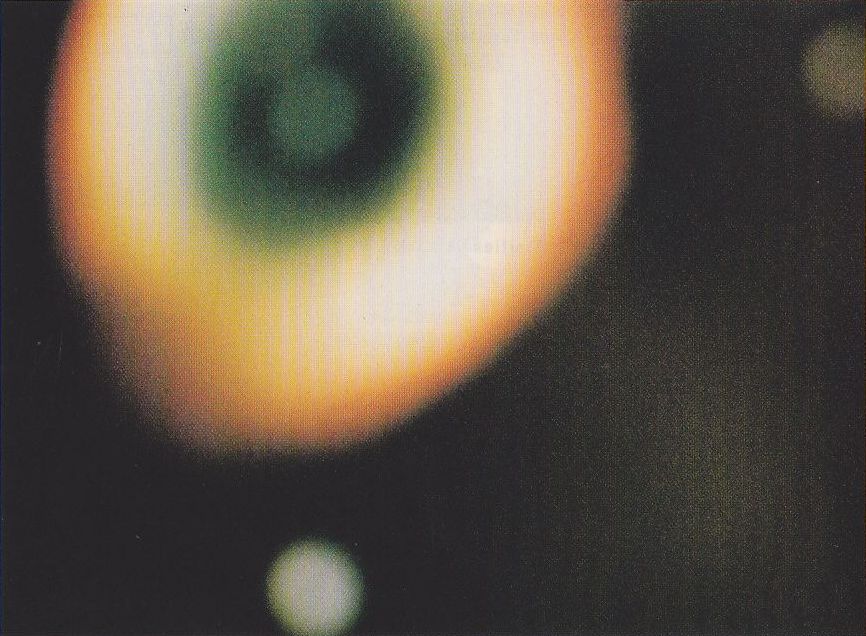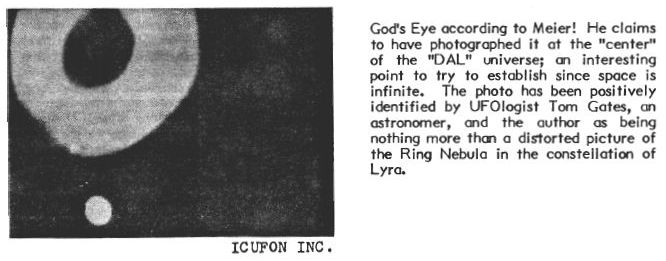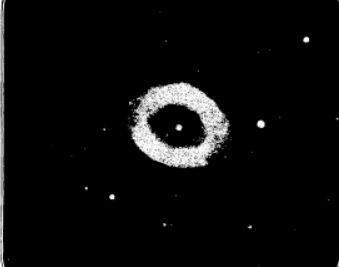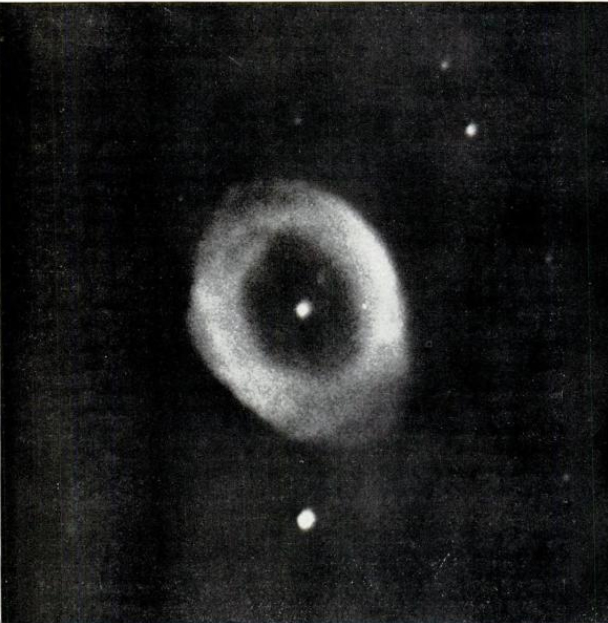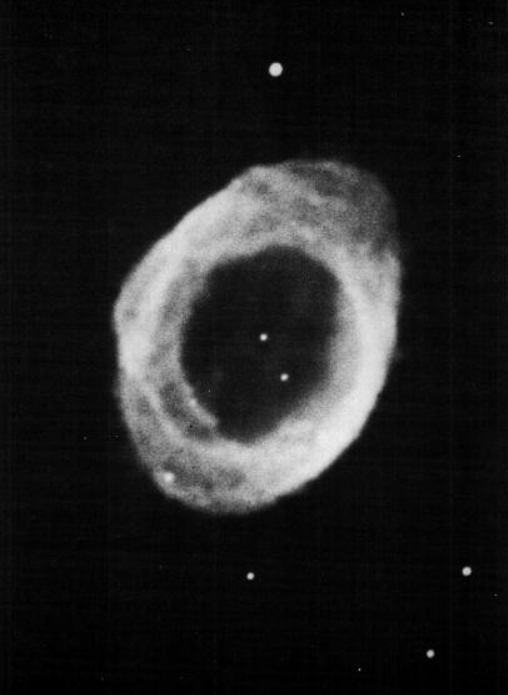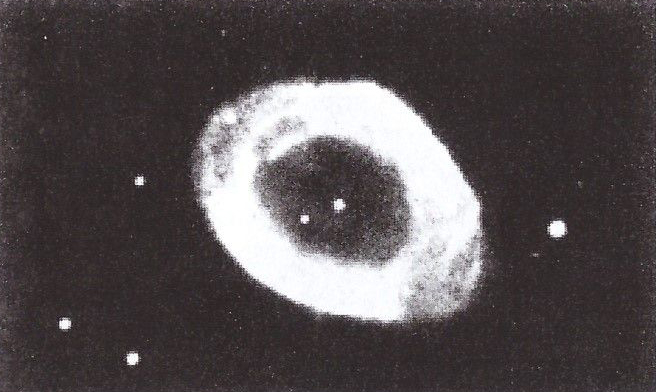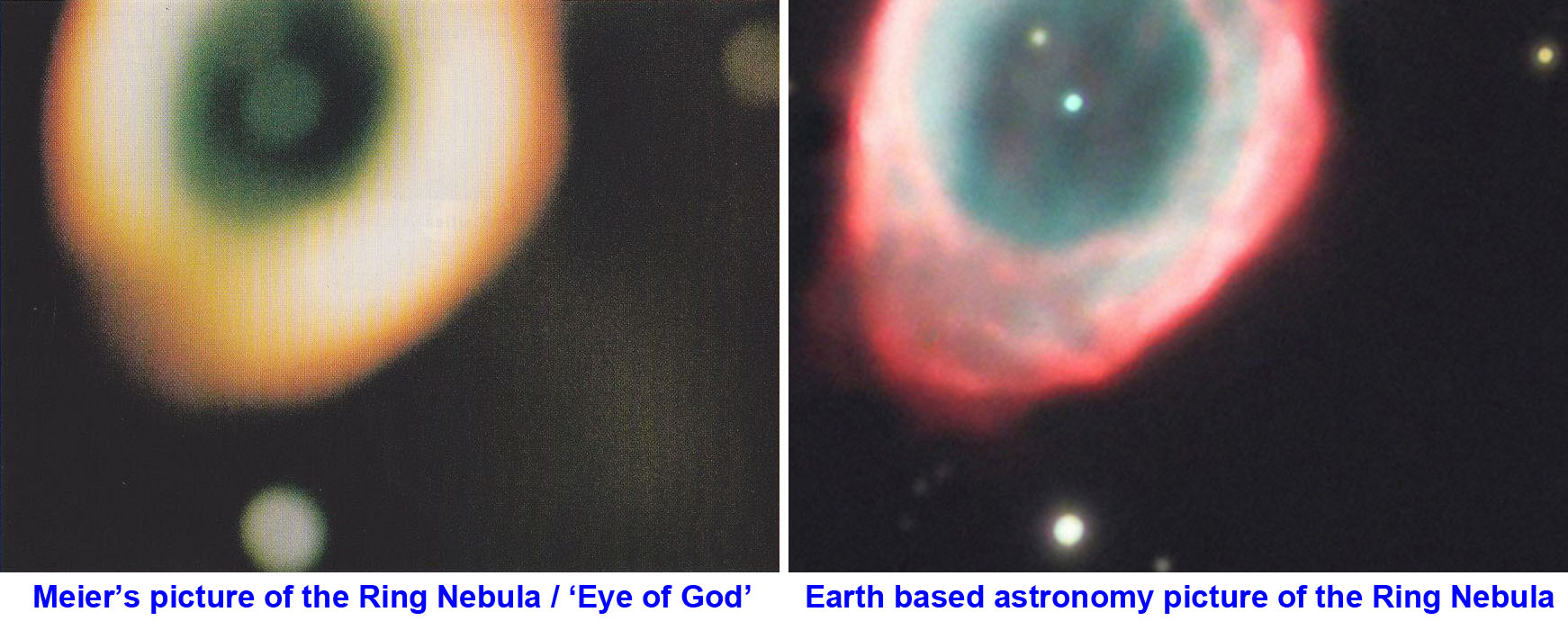Contents
INTRODUCTION
In Contact Report 30 Semjase tells Meier to prepare for a journey through space, in which he would be given the opportunity to photograph star systems, nebulae and galaxies etc. She also tells him that they will visit the “original home of the human races from afar” in the Lyra system. There they will see what the Plejaren call the JHWHMATA (‘Eye of God’), which is known on Earth as the Ring Nebula or M57, a planetary nebula discovered in the year 1779, about 1 light year across and around 2,300 light years away from the Earth.
The ‘great journey’ through space, which is described in Contact Report 31, took place between July 17-22, 1975, for a great part on-board of the Great Spacer, the mother ship of the Plejaren. This ship is allegedly capable of making ‘hyper-leaps’ or hyperspace jumps, jumping from one place in the universe to another in an instant, and Meier was allegedly taken to different star systems in our galaxy and also to star systems in different galaxies. As described in Contact Report 31 (and also in CR 210), Meier was also taken relatively close to the Ring Nebula and was given the opportunity to take photographs of it:
Ptaah:
(…)
155. When you have finished taking your pictures here, we will jump to JHWHMATA.
(My work doesn’t take long, and then we set on a new hyper-leap, where everything takes place the way I am used to. This time I look at the stars again, and now I suddenly notice a gigantic image: Surrounded by countless stars of all sizes, something like a colossal eye stares at me through the blackness of space. It must be very far away, but it’s very easy to see: A gigantic eye that stares through space; this can only be the JHWHMATA, the “Eye of God”.)
Semjase:
209. It’s unmistakable, isn’t it?
Billy:
Yes, and it is gigantic.
Semjase:
210. I have already explained to you the origin and cause of this structure.
Billy:
I know, it’s all written down.
Ptaah:
156. It is for us a symbol of evil lust for power and domination, a symbol of hate, destruction and human madness, that in contrast to other similar and natural formations, is the work of man.
Billy:
I know, Semjase has explained it all to me. Here in this constellation was also the original home of the first Earth human races.
Ptaah:
157. Yes, that was a long time ago.
158. For the Earth human it’s just an image in the Universe, called the Ring Nebula, but for us it is of very great importance.
159. Occupy yourself now with your photographic equipment and have the next five minutes for yourself.
160. We will now experience several additional leaps, and you will have about 20 seconds in between to take pictures.
161. Just remember, however, the order of locations for when you label your pictures later.
162. For this purpose I will tell you the locations in your earthly designations.
163. What you see above from here, you call M57.
Timeline of Ring Nebula picture
INVESTIGATION & ANALYSIS
Below is one of Meier’s Ring Nebula pictures (source: Und sie fliegen doch!, 1991) which Meier allegedly photographed during his space journey. This the only Ring Nebula picture in the FIGU literature but according to Kal K. Korff’s 1995 book ‘Spaceships of the Pleiades‘ there are or were (at least) 4 Ring Nebula pictures. Furthermore, below picture seems to have been cropped. For a complete picture (black and white version), see Fig. 106 on pg. 266 of ‘Spaceships of the Pleiades’.
Criticism and counter criticism
Col. Colman S. von Keviczky (1980)
Col. Colman S. von Keviczky (1909-1998), an internationally prominent ufologist and Hungarian military scientist, founded ICUFON (Intercontinental U.F.O. Galactic Spacecraft Research and Analytic Network) in 1966. He published a report (see pages 114-120 of the book – Ausschnitte aus Zeitungen und Journalen) on the Meier case, which was sent to Wendelle Stevens and Thomas K. Welsch of Genesis III Productions, Ltd. on June 9, 1980. On page 5 of this report Meier’s picture of the Ring Nebula is briefly mentioned:
Kal K. Korff (1981)
In March 1981 Kal K. Korff, with editorial assistance from William L. Moore, published a booklet titled The Meier Incident: The most infamous hoax in Ufology. On page 24 he writes:
“Meier also claims to have visited other planets, to have travelled in time to both the past and the future, and to have taken close range photographs of the Apollo/Soyuz space capsule link-up in 1975, prehistoric pterodactyls, San Francisco sinking into the Bay after a major earthquake, and even one of God’s eyes. (Curiously, when asked why he didn’t photograph both of God’s eyes, Meier replied that it wasn’t possible since the other was winking at his Pleiadean companion – Semjase!)”
On page 26 of this 124 pages booklet, the Ring Nebula photo is printed (which he got from Col. Colman S. von Keviczky, who in turn got it from Hans Jacob) along with a brief comment:
Curiously both Colman von Keviczky and Korff (including William L. Moore) assert that Meier claims this photo literally shows one of the eyes of God/The Creator. This seems to be a misunderstanding of the Plejaren’s name for the Ring Nebula or M57 (this name of the nebula is indeed mentioned in CR 30 and CR 31): JHWHMATA, or Eye of God, which only refers to it’s appearance and history. According to the Plejaren (see CR 30) it was created by “a barbaric and power-hungry YHWH” (YHWH is supposedly a title for a highly evolved human being) who destroyed a star (along with himself) in order to create this ‘memorial’ that supposed to signify his power. This misunderstanding is also addressed by Wendelle Stevens in Message from the Pleiades Vol. 1, (1988) on page 282:
“This logical reference to “The Eye of God” in Pleiadian history has been facitiously twisted by the jealous antagonists of this case into a derisive statement that “Meier claims to have looked into the eye of God”, which only reveals their actual ignorance of the facts in this case.”
Von Keviczky and Korff also assert that Meier claims to have taken this photo in (the center of) the DAL universe. It is not clear where this assertion is based on but according to CR 31, Meier indeed visited the DAL universe which is parallel to our universe called as DERN. According to the same contact report, Meier photographed the Ring Nebula before he makes his journey into the parallel DAL universe. As far as we know, there never was any mention about photographing the Eye of God in the “center” of this parallel DAL universe. Perhaps this misunderstanding arose from only considering the captions on the photos and not reading the contact reports which provide the alleged history behind the Ring Nebula and the reason for the Plejaren to call it ‘God’s Eye’ or the ‘Eye of God’ (German: ‘Das Auge Gottes’).
James Deardorff (1988)
In 1988 the late James W. Deardorff, research Professor Emeritus (OSU), wrote an unpublished critique of Korff’s 1981 book (see above) titled – Review of Korff’s Report: “The Meier Incident — The Most Infamous Hoax In Ufology”. On page 9 he briefly mentions Korff’s analysis of the Ring Nebula picture:
“If Meier was able to photograph the Ring Nebula, also called “God’s Eye,” from a position in the galaxy far from the solar system, it ought to have a slightly different appearance, since the outwardly spreading ring from the ancient supernova explosion is not perfectly symmetric. Korff reports (p. 26) an astronomer’s opinion that Meier’s photo of it is a distorted picture of the Ring Nebula. That is about the description one would expect if Meier’s photo was indeed taken in the manner claimed, from a different viewing angle in space. (Meier did not claim to photograph it from a different universe according to his contact notes, in contradiction to a statement of Korff.)”
It seems James Deardorff essentially supports Korff’s analysis which indicated that Meier’s picture is a distorted picture of the Ring Nebula in the constellation of Lyra, as also has been indicated by the astronomer Tom Gates.
Guido Moosbrugger (1991)
The late Guido Moosbrugger, FIGU co-founder and Core Group member, published a book – Und sie fliegen doch! (1991/2001/2004/2012) – in which he responds to the criticism on the Ring Nebula picture by Col. Colman S. von Keviczky in his analysis (1980) and by Kal Korff in his 1981 booklet. His 3-point rebuttal basically goes as follows (paraphrased):
- Meier/FIGU never claimed the picture was anything but a picture of the Ring Nebula, contrary to what Col. Colman S. von Keviczky and Kal Korff assumed.
- The copy of Meier’s photo presented by ICUFON is a very poor copy, because the ball shaped object in the center isn’t visible, which gives the nebula the appearance of an eye and “considerably” distinguishes Meier’s picture from Earth based astronomy pictures.
- According to Semjase’s information the Ring Nebula was created artificially through a deliberate destruction by a barbaric and power hungry JHWH. Therefore it is completely absurd to compare the Ring Nebula, which is called ‘Eye of God’ by the Plejaren, to the almighty power of Creation of the universe (the 2012 edition of USFD adds: “or relocate it to the DAL-universe”).
Regarding Point 1 and 3, it is true that nowhere in the FIGU material has it been claimed as literally a picture of the eye of God or Creator. It was only described (in CR 30 and CR 31) that Meier was given the opportunity to take photographs of the Ring Nebula (from inside the mother ship of the Plejaren called the Great Spacer). As mentioned earlier this erroneous assumption by Colman S. von Keziczky and Kal Korff was already addressed by Wendelle Stevens.
Regarding Point 2, Guido seems to make the claim that Meier’s picture, unlike the astronomical pictures taken by scientists and astronomers using large telescopes, has a ‘ball’-shaped object inside the Ring Nebula which gives the appearance of a giant eye gazing out into space. This according to Guido differentiates the Meier’s photograph “considerably” from the astronomical observatory pictures. However, astronomical pictures also contain this ‘ball’ shape which actually is a central white dwarf or planetary nebula nucleus (PNN) of 15.75 V visual magnitude,[15] whose mass is approximately 1.2 M☉ (solar masses). For example see the following astronomical pictures* of M57, taken decades before Meier allegedly took his pictures in July 1975, published in the science paper ‘The Ring Nebula in Lyra’ (1904), The Popular Science Monthly (pg. 230, Sep. 1915) and in Burnham’s Celestial Handbook (pg. 1168, 1966/1978).
* black and white versions since it is hard to find a color version online
Korff wrote in his 1981 booklet:
“Curiously, when asked why he didn’t photograph both of God’s eyes, Meier replied that it wasn’t possible since the other was winking at his Pleiadean companion – Semjase!”
In the English translations from 2001 and 2004 editions of ‘Und sie fliegen doch’ there is a citation (which is absent in the German editions of 1991 and 2012) which says: “Billy was teasing“. It is curious Korff didn’t figure that out, since it seems rather obvious.
Kal Korff (1995)
In 1995, Kal Korff published his book ‘Spaceships of the Pleiades‘, in which he addressed the Ring Nebula picture more extensively compared to his 1981 report. Strangely, he persists in his assertion that Meier claims to have literately photographed the ‘Eye of God’, which on page 263 he substantiates with a picture from Hans Jacob’s photo binder which shows a Ring Nebula picture with the caption:
“Das AUGE GOTTES od. JHWMATA: Ringnebel im Sternbild der Leier/Lyra ca. 5600 LJ entfernt von der Erde”
“The EYE OF GOD or JHWMATA: Ring Nebula in the constellation Lyra ca. 5600 LY away from Earth”
It clearly mentions the Ring Nebula in the Lyra constellation, so it’s highly strange this obvious misunderstanding is still not resolved. Apparently he was also still not aware about the reasons given by the Plejaren/Meier why they call it the ‘Eye of God’.
Even though Korff stated that Meier mentioned that Hans Jacob’s photo binder contained 4 pictures of the Ring Nebula, he only presented his analysis on 1 of those 4 pictures. After comparing Meier’s picture with an astronomical Earth observatory picture Korff concluded that Meier’s four pictures “are really out-of-focus copies of Earth-based astronomy pictures of the Ring Nebula, located in the constellation of Lyra!”
On page 262 Korff writes:
“Figure 105 shows the Ring Nebula as it appears when photographed from Earth through a telescope. Figure 107 on page 264 illustrates what happened when I took the same Earth-based picture of the Ring Nebula, turned it upside down, flipped it backwards, rephotographed it deliberately out-of-focus, and enlarged it. The result is identical to Meier’s pictures of what we are told is “God’s Eye.”
Note: The astronomy picture which Korff referred to as Figure 105 seems to be a cropped version since a star that is supposed to match the right star in the final Figure 107 is out of the frame.

Fig. 107 – Korff’s recreation of Meier’s “Eye of God”, achieved by manipulating an observatory picture
Christian Frehner (1998)
In the article titled ‘The false allegations and intrigues of Kal K. Korff’ published in FIGU Bulletin 14 in February 1998, FIGU core group member and director of Semjase Silver Star Center (SSSC), Christian Frehner addresses Korff’s claims taken from his 1995 book, including his criticism on the Ring Nebula pictures. Here too, only Korff’s erroneous assumption that Meier claims to have literally photographed the ‘Eye of God’ is rebutted.
However, Frehner ignores the main point of criticism that Meier’s picture (even though it’s of poor quality) matches to those of Earth based astronomy pictures. But since Korff seems to have wrongly assumed that Meier claimed this picture was literally of ‘God’s Eye’, he apparently didn’t consider Meier’s actual claim that it was a picture of the Ring Nebula taken from some position in space relatively close to it (although no specific data on the relative position were given in the contact reports), so let’s consider that possibility here.
If Meier really took a picture from the Ring Nebula from a different position than from our Earth/Solar System, one would expect differences between his picture and Earth based astronomy pictures regarding the shape and appearance of the nebula and the back- and fore-ground stars. Although Meier’s picture is of very poor quality and out of focus, there are 4 blurry stars visible in the picture, two are in or near the center of the Nebula, and two are outside the Nebula.
Do they match the stars in Earth based astronomy pictures? As a matter of fact they do, as can be clearly seen in the side to side comparison picture below. Also see this animation for a better comparison. This clearly indicates that Meier’s picture is nothing more than a poor distorted reproduction of an Earth based astronomy picture. Since the Ring Nebula in Lyra has been recorded since 1779, the year of its discovery, there were already abundant sources in 1975 from which Meier’s picture could have been taken.
Jeroen Janssen (2003)
In 2003 Jeroen Jansen, a FIGU supporter from Holland, published two versions (large and small) of the same article online in which he responded to Kal Korff’s criticism in his 1995 book ‘Spaceships of the Pleiades‘. Regarding Korff’s criticism on Meier’s Ring Nebula pictures Jansen basically makes the following points:
- Korff wrongly assumed that Meier claimed his Ring Nebula picture(s) literately represented Eye of God, because the took the name the Plejaren (‘Eye of God’) literally
- Korff’s charges on the authenticity of Meier’s space pictures are irrelevant since these pictures were claimed by Meier to have been tampered with as stated in CR 68, November 12, 1976
- According to a statement by Wendelle Stevens on these space pictures on pg. 338 of Message from the Pleiades, Vol. 1, the Ring Nebula picture could perhaps be an observatory picture used by Meier/FIGU in order to illustrate to their visitors what Meier supposedly saw and photographed since his original photographs were allegedly lost, damaged or stolen.
Point 1 has already been discussed.
Regarding point 2, there is no such information pertaining to the manipulation of pictures being discussed in CR 68. Besides this, “God’s Eye” picture has been defended by the co-founder and Core Group member of FIGU as a genuine one in all of his Und sie fliegen doch! editions published in 1991, 2001, 2004 and 2012.
Regarding point 3, the Wendelle’s statement which Jansen refers to reads as follows:
“The disappointment was crushing, and Meier forced to resort to collecting other images to illustrate what he was trying to describe to others, including observatory pictures of some of the stellar wonders. Some of these became mounted in the picture album by his friends, and eventually became confused by others as the pictures from the trip. In fact that was what we were told once by somebody there also, which we knew was not true, because those observatory views are only possible from the point in space occupied by the Earth, and through special hydrogen and other filters not available for small cameras. Eduard Meier has never told us that those pictures were taken on that extended trip.”
Wendelle didn’t cite the source of this information which states that Meier was forced to resort to collecting Earth based astronomy pictures to illustrate to people what he saw and photographed during his space journey. We weren’t able to find any such information published by Meier/FIGU. Although Wendelle didn’t refer to any particular space pictures, the Ring Nebula picture might have been one of those Earth based astronomy pictures used to illustrate what Meier saw on his journey. However, even in the latest German edition of ‘Und sie fliegen doch’ from 2012 it is still claimed to be a genuine picture taken by Meier.
CONCLUSION
We investigated a picture of the Ring Nebula (M57), called the ‘Eye of God’ by the Plejaren, which Meier allegedly photographed during his Great Journey. When compared to an Earth based astronomy picture of the Ring Nebula, the details – shape and appearance of the nebula, the number of visible stars (four) in the frame and their locations – seen on Meier’s picture are found to be the same, which means that Meier’s picture is most likely just a blurry reproduction of an astronomy picture.
5,575 total views, 2 views today

